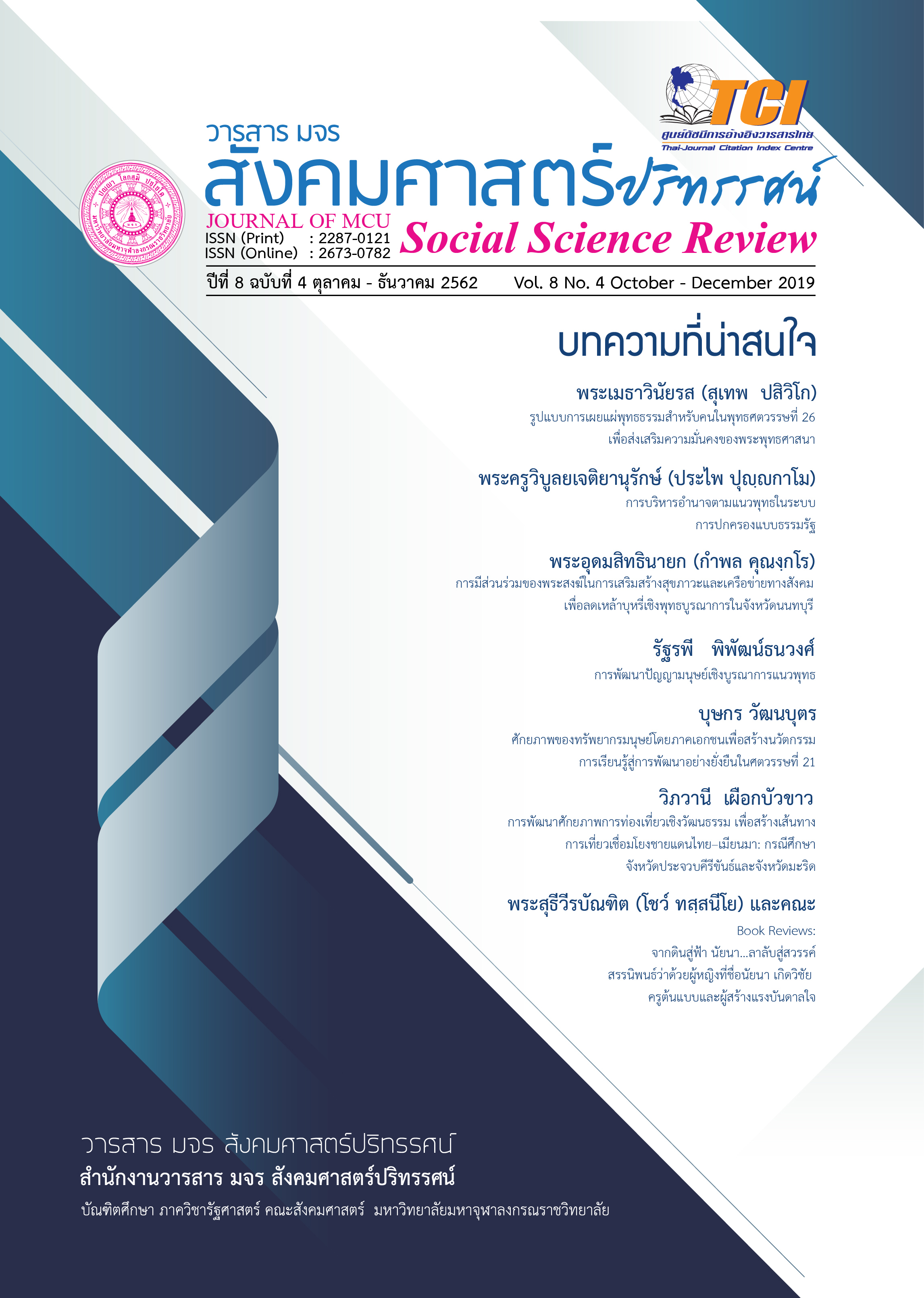การจัดการการท่องเที่ยวเชิงเกษตรในจังหวัดระยอง
คำสำคัญ:
การจัดการ, การท่องเที่ยวเชิงเกษตร, การท่องเที่ยว, นักท่องเที่ยวบทคัดย่อ
ดุษฎีนิพนธ์ฉบับนี้มีวัตถุประสงค์ 3 ประการคือ 1. เพื่อศึกษาบริบททั่วไปของการท่องเที่ยวเชิงเกษตรในจังหวัดระยอง 2. เพื่อศึกษาปัจจัยที่มีผลต่อการท่องเที่ยวเชิงเกษตรในจังหวัดระยอง และ 3. เพื่อเสนอวิธีการทางพระพุทธศาสนาในการสนับสนุนการจัดการการท่องเที่ยวเชิงเกษตรในจังหวัดระยอง
ระเบียบวิธีการวิจัยเป็นแบบผสานวิธี การวิจัยเชิงคุณภาพรวบรวมข้อมูลโดยการสัมภาษณ์เชิงลึกกับผู้ให้ข้อมูลสำคัญจำนวน 21 คน และสนทนากลุ่มกับผู้ทรงคุณวุฒิที่มีความเชี่ยวชาญด้านการท่องเที่ยวเชิงเกษตรจำนวน 12 คน โดยการเลือกแบบเจาะจงและวิเคราะห์ข้อมูลโดยใช้เทคนิคการวิเคราะห์เนื้อหาเชิงพรรณนา การวิจัยเชิงปริมาณเก็บข้อมูลจากกลุ่มตัวอย่างคือนักท่องเที่ยวชาวไทยจำนวน 400 คน โดยการสุ่มแบบบังเอิญ (Accidental Sampling) คำนวนขนาดกลุ่มตัวอย่างจากการเปิดตารางสำเร็จรูปของทาโร่ยามาเน่ เครื่องมือที่ใช้ในการเก็บรวบรวมข้อมูลเป็นแบบสอบถาม มีค่าความเชื่อมั่นทั้งฉบับเท่ากับ 0.969 สถิติที่ใช้ในการวิเคราะห์ข้อมูลคือ ความถี่, ร้อยละ, ค่าเฉลี่ย และค่าเบี่ยงเบนมาตรฐาน
ผลการวิจัยพบว่า
- บริบททั่วไปของการท่องเที่ยวเชิงเกษตรในจังหวัดระยองเหมาะสำหรับการพักผ่อนกับครอบครัว นักท่องเที่ยวชาวไทยส่วนใหญ่ชอบสวนผลไม้ ระยะเวลาที่เหมาะสมสำหรับการท่องเที่ยวเชิงเกษตรคือค้างคืน 1 คืน และช่วงเวลาที่เหมาะสมคือวันเสาร์-อาทิตย์ แหล่งข้อมูลที่สำคัญสำหรับการท่องเที่ยวเชิงเกษตรคือสื่อออนไลน์จากที่ต่างๆ
- ปัจจัยที่ส่งผลต่อการท่องเที่ยวเชิงเกษตรในจังหวัดระยองโดยใช้ทฤษฎีส่วนประสมการตลาดอยู่ในระดับมาก 1) ด้านแหล่งท่องเที่ยว นักท่องเที่ยวส่วนใหญ่ให้ความสำคัญเรื่องการมีระบบรักษาความปลอดภัยที่ดีและความมีเอกลักษณ์ที่สะท้อนถึงวัฒนธรรมท้องถิ่น 2) ด้านราคา นักท่องเที่ยวส่วนใหญ่ให้ความสำคัญเรื่องราคาที่เหมาะสมและมีความคุ้มค่ากับประโยชน์ที่ได้รับ 3) ด้านสถานที่ตั้ง นักท่องเที่ยวส่วนใหญ่ให้ความสำคัญเรื่องการค้นหาเส้นทางผ่าน GPS และการมีป้ายบอกทางที่ชัดเจนตลอดเส้นทาง และ 4) ด้านการบริการ นักท่องเที่ยวส่วนใหญ่ให้ความสำคัญเรื่องการดูแลเอาใจใส่นักท่องเที่ยวที่ดีและให้บริการอย่างรวดเร็ว
- วิธีการทางพระพุทธศาสนาในการสนับสนุนการจัดการการท่องเที่ยวเชิงเกษตรตามหลักสัปปุริสธรรมเพื่อคุณภาพชีวิตของชุมชนในจังหวัดระยอง คือ 1) ธัมมัญญุตา (รู้จักเหตุ) แหล่งท่องเที่ยวเชิงเกษตรวางแผนการจัดการการท่องเที่ยวเชิงเกษตรและการกำหนดบทบาทในการทำงานของแต่ละคนได้อย่างเหมาะสม 2) อัตถัญญุตา (รู้จักผล) แหล่งท่องเที่ยวเชิงเกษตรทราบเกี่ยวกับผลดีหรือผลเสียที่จะเกิดขึ้นกับนักท่องเที่ยวเป็นอย่างดี และนำมามาวางแผนเพื่อให้บรรลุวัตถุประสงค์ขององค์กร 3) อัตตัญญุตา (รู้จักตน) แหล่งท่องเที่ยวเชิงเกษตรได้ดำเนินกิจการสอดคล้องกับสภาพแวดล้อมของชุมชนและเหมาะสมกับความรู้ของผู้ประกอบการ ซึ่งนำไปสู่การบรรลุวัตถุประสงค์ขององค์กร 4) มัตตัญญุตา (รู้จักประมาณ) โดยภาพรวม แหล่งท่องเที่ยวเชิงเกษตรมีการดำเนินกิจการได้อย่างเหมาะสมโดยยึดหลักปรัชญาเศรษฐกิจพอเพียง 5) กาลัญญุตา (รู้จักกาล) แหล่งท่องเที่ยวเชิงเกษตรเปิดให้บริการตรงเวลา และให้บริการอย่างเหมาะสมกับกาละเทศะ 6) ปริสัญญุตา (รู้จักชุมชน) แหล่งท่องเที่ยวเชิงเกษตรได้ดำเนินกิจการสอดคล้องกับวัฒนธรรมชุมชน และสร้างประโยชน์ให้กับชุมชน 7) ปุคคลัญญุตา (รู้จักบุคคล) แหล่งท่องเที่ยวเชิงเกษตรปฏิบัติต่อนักท่องเที่ยวและบุคคลอื่นๆอยู่ในระดับที่พึงพอใจ และสามารถสรรหาบุคลากรที่ดีเข้ามาปฏิบัติงานได้อย่างเหมาะสม
เอกสารอ้างอิง
Phrakru Sriworawinit. (2016). “Community Participation in The Buddhist Archaeological Management in Phayao Province”, Journal of MCU Social Science Review. 5 (2) (May – August): 141.
Teerawatt Sankom. (2018). “A Strategy for Sustainable Cultural Tourism Development in Accordance with Buddhism of Local Administrative Organizations in Loei Province”, Journal of MCU Social Science Review, 7 (2) (Special Issue) (April - June): 410-411.
Marayat Yothongyos. (2019). Determining the sample for research, [Online], Source: https://www.fsh.mi.th/km/wp-content/uploads/2014/04/resch.pdf [13 March 2019].
ดาวน์โหลด
เผยแพร่แล้ว
รูปแบบการอ้างอิง
ฉบับ
ประเภทบทความ
สัญญาอนุญาต
ลิขสิทธิ์ (c) 2019 วารสาร มจร สังคมศาสตร์ปริทรรศน์

อนุญาตภายใต้เงื่อนไข Creative Commons Attribution-NonCommercial-NoDerivatives 4.0 International License.
เพื่อให้เป็นไปตามกฎหมายลิขสิทธิ์ ผู้นิพนธ์ทุกท่านต้องลงลายมือชื่อในแบบฟอร์มใบมอบลิขสิทธิ์บทความให้แก่วารสารฯ พร้อมกับบทความต้นฉบับที่ได้แก้ไขครั้งสุดท้าย นอกจากนี้ ผู้นิพนธ์ทุกท่านต้องยืนยันว่าบทความต้นฉบับที่ส่งมาตีพิมพ์นั้น ได้ส่งมาตีพิมพ์เฉพาะในวารสาร มจร สังคมศาสตร์ปริทรรศน์ เพียงแห่งเดียวเท่านั้น หากมีการใช้ภาพหรือตารางหรือเนื้อหาอื่นๆ ของผู้นิพนธ์อื่นที่ปรากฏในสิ่งตีพิมพ์อื่นมาแล้ว ผู้นิพนธ์ต้องขออนุญาตเจ้าของลิขสิทธิ์ก่อน พร้อมทั้งแสดงหนังสือที่ได้รับการยินยอมต่อบรรณาธิการ ก่อนที่บทความจะได้รับการตีพิมพ์ หากไม่เป็นไปตามข้อกำหนดเบื้องต้น ทางวารสารจะถอดบทความของท่านออกโดยไม่มีข้อยกเว้นใดๆ ทั้งสิ้น





